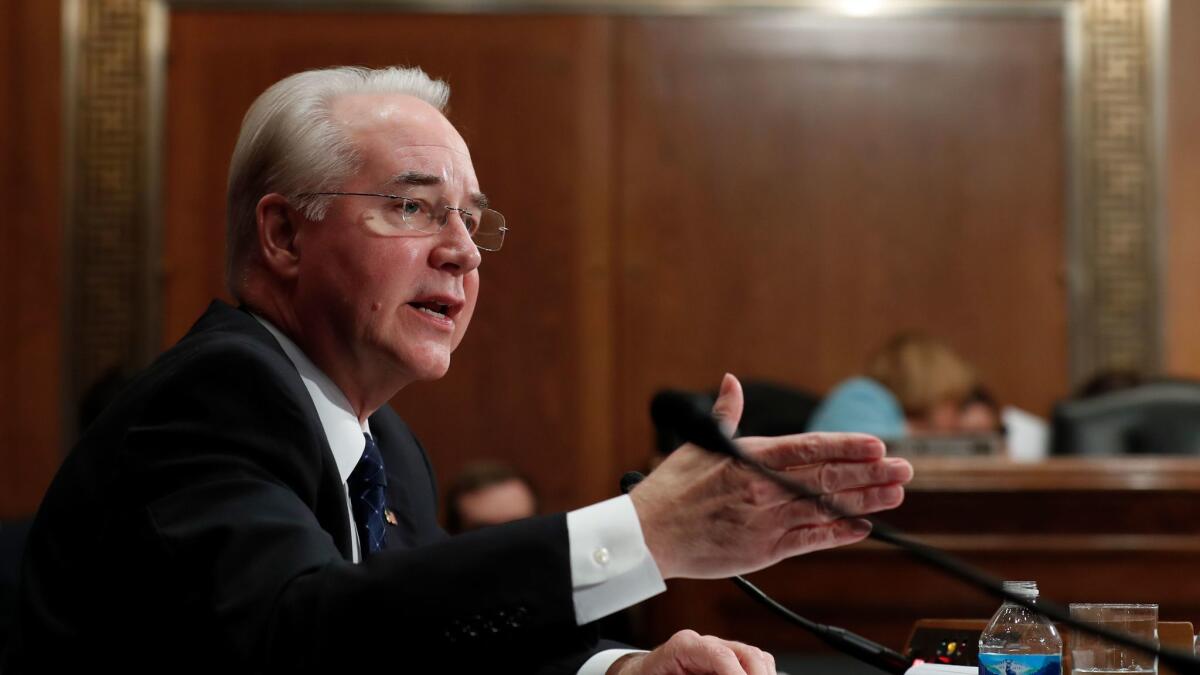Column: Trump administration uses bogus numbers on Obamacare — again

Health and Human Services Secretary Tom Price was quick off the mark Monday after his agency released fresh data on “effectuated enrollments” — that is, Americans who not only chose an Affordable Care Act individual health plan for 2017, but secured coverage by paying their first monthly installment.
The data, according to HHS, “show a decline in the number of Americans who have actually purchased coverage on the exchanges, with cost being a primary concern.” Price used that conclusion to assert in a statement, “Not surprisingly, as costs continue to go up, fewer Americans can afford to pay more and get less for healthcare.”
He added: “Many individuals and families across the country are tired of having their healthcare options dictated to them by Washington — particularly when those limited options are unaffordable. That’s why every day we are working on behalf of President Trump on solutions that will show a little humility from the federal government, equip states to serve their unique and diverse populations, and put healthcare decisions in the hands of patients, families, and their doctors.”
Um, sure. Except that the HHS figures appear to have been fudged, in a way that makes the effectuated enrollments look worse than they are. The fudging was caught by the eagle-eyed Charles Gaba of ACA Signups, who charitably called it “misleading.” We say “charitably,” because this incident follows one a few weeks ago in which the same agency issued what we labeled a “stunningly dishonest” analysis of ACA premium increases.
Many individuals and families across the country are tired of having their healthcare options dictated to them by Washington.
— Health and Human Services Secretary Tom Price
Getting accurate data about ACA enrollments from the Department of Health and Human Services is more important than ever now, as the Senate works on its ACA repeal bill behind closed doors—via secret meetings of a small group of Republican Senators, with no public hearings likely to be scheduled before a vote. Bogus, manipulated data from HHS only helps that process, as ACA foes can use it to justify their behind-the-scenes dismantling of the law.
Let’s look at the latest machination. Monday’s report places the number of effectuated enrollees at 10,330,759 as of March 15. The document compares that figure to total plan selections by 12,216,003 individuals as of Jan. 1. That means that only 84.6% followed through on their plan selections by paying the first month’s premiums — “seemingly a worse drop-off rate than the prior two years,” Gaba observes. The retention rate was 87.2% in 2015 and 87.4% in 2016. This drop-off is what gave Price the evidence to label “cost … a primary concern” of exchange enrollees.
But the earlier figures were as of March 31 those years, not March 15. And the HHS release refers to 10.33 million as the number of enrollees who had made their payments for plans starting in January and February. Those who made payments after Jan. 15 and before Jan. 31 in 47 states and the District of Columbia had to wait until March to start coverage. (In the other three states, enrollees could make payments by Jan. 24 and still be eligible to start coverage in February.) Who’s missing? Some 496,717 people who signed up in the second half of January, and aren’t counted in the “effectuation” figures.
The discrepancy may not look like much, but it makes the HHS figures fishy. Gaba contends that the proper comparison should be between the number of people who signed up by Jan. 15 (in order to obtain coverage no later than Feb. 1), and the number who failed to pay by March 15. But as of Jan. 15, only 11,719,286 had signed up for coverage. that means the share of January and February enrollees who had paid their first monthly premium was 88.2% — an improvement, not a decline, compared to previous years. Gaba asks, quite properly, why HHS didn’t calculate all its figures up to March 31, since it undoubtedly has those in hand.
Gaba is suspicious in part because of the shenanigans HHS played with its previous data release. In that case, as we reported, the agency claimed that Obamacare premiums had “doubled” from 2013 through 2017. Among the problems with that analysis was that there were no Obamacare premiums in 2013. The exchanges didn’t exist until 2014, so 2013 premiums were for a cherry-picked insurance pool that favored the young and healthy, used high premiums to discourage those with medical conditions from signing up or rejected them outright, and didn’t provide coverage that is mandated under the ACA, such as maternity services.
The HHS paper also failed to acknowledge that the vast majority of enrollees were sheltered from all or part of the premium increases from 2014 on by subsidies, which also increased in 2014-2017 — sometimes at a faster pace than premiums.
It’s proper to note that attrition in the ACA exchange enrollment base is a natural phenomenon, settling in at about 12% in the first quarter every year and continuing through the following nine months. Churn in the individual market is an old story, predating the ACA.
That’s because many people customarily have used the individual market as a bridge of coverage between employers, or before they transition to Medicare; fewer have stayed in that market voluntarily, because it’s generally more expensive than employer-sponsored insurance and Medicare, and always has been. That’s a fact of life in the health insurance business, and one that HHS is certainly within its rights to measure. But shading the truth about it — that’s not within HHS’ rights, or Price’s.
Keep up to date with Michael Hiltzik. Follow @hiltzikm on Twitter, see his Facebook page, or email [email protected].
Return to Michael Hiltzik’s blog.
MORE FROM MICHAEL HILTZIK
Trump’s sabotage of Obamacare has just claimed 10,000 new victims
How ‘price-cutting’ middlemen are making crucial drugs vastly more expensive
Desperate to keep its Obamacare exchange open, New York plays hardball with health insurers
More to Read
Sign up for Essential California
The most important California stories and recommendations in your inbox every morning.
You may occasionally receive promotional content from the Los Angeles Times.











